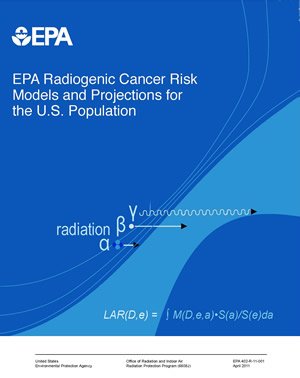Blue Book: EPA Radiogenic Cancer Risk Models and Projections for the U.S. Population
EPA Radiogenic Cancer Risk Models and Projections for the U.S. Population, also known as the Blue Book, is a revision of EPA's methodology for estimating cancer risks from radiationEnergy given off as either particles or rays. exposure.
These updates are based on the National Research Council's 2006 report "Biological Effects of Ionizing Radiation (BEIR VII)," as well as on other updated science.
Background
The Blue Book calculates cancer risk estimates separately by age at exposure, sex and potentially affected organ. Its risk estimate methodology reflects the scientific consensus of the BEIR VII committee. The Blue Book presents new EPA cancer incidence and mortality risk coefficients for the U.S. population from exposure to low doses of ionizing radiationRadiation with so much energy it can knock electrons out of atoms. Ionizing radiation can affect the atoms in living things, so it poses a health risk by damaging tissue and DNA in genes.. The document also presents the scientific basis for the estimates.

The document takes into account recommendations made by EPA's Science Advisory Board (SAB), which completed its review in January 2010. The SAB relied on advice from its Radiation Advisory Committee panel of non-EPA scientists chosen for their objectivity, integrity and expertise in radiation science and protection.
The Blue Book has undergone an extensive peer review process, which included opportunities for the public and stakeholders to provide comment.
BEIR VII
As in BEIR VII, the models in the Blue Book describe how radiogenic cancer risks depend on such factors as:
- Age of exposure.
- Age at which person might get cancer.
- Sex.
- Type of cancer.
However, a number of extensions and modifications to the BEIR VII models have been implemented:
- Risk estimates for alpha particles.
- Risk estimates for basal cell carcinomas, kidney cancer, bone sarcomas and cancers from prenatal exposures.
- More extensive analysis of uncertainties associated with the radiogenic risk estimates.
A large body of epidemiological and radiobiological data support the risk models. In general, results from these data are consistent with a linear no-threshold (LNTThe assumption that the risk of cancer increases linearly as radiation dose increases. This means, for example, that doubling the dose doubles the risk and that even a small dose could result in a correspondingly small risk. Using current science, it is impossible to know what the actual risks are at very small doses.) dose response model in which the risk of inducing a cancer in tissue irradiated by low doses of radiation is proportional to the dose received.
Errata
In August 2024, EPA included an errata page in the 2011 document. The errata corrects the EPA bone risk model due to a misinterpretation of a publication by Nekolla et al. (2000), in addition to correcting typos and word choice errors in the original document. The errata page is at the back of the Blue Book PDF available online. It is also available as a stand-alone PDF.
Get a Copy
EPA established a docket for the release of the Blue Book. View Docket ID No. EPA-HQ-OAR-2011-0436 on Regulations.gov. When making regulatory decisions, EPA and other federal agencies use dockets to make documents publicly accessible.
Electronic Version
EPA Radiogenic Cancer Risk Models and Projections for the U.S. Population (pdf)
Errata for EPA Radiogenic Cancer Risk Models and Projections for the U.S. Population (pdf)
Also see Estimating Radiogenic Cancer Risk.
Download Blue Book materials in EPA Docket ID No. EPA-HQ-OAR-2011-0436 on Regulations.gov.
Hard Copies
- To request a hard copy of the Blue Book, please e-mail radiation.questions@epa.gov.
- There are also several options for reviewing or obtaining copies of docket materials:
Blue Book Docket Location
| Official EPA Air and Radiation Docket Docket and Location |
Hours of Operation | Contact |
|---|---|---|
|
Reading Room: Air and Radiation Docket and Information Center Mailing Address: Air and Radiation Docket |
Monday-Friday: (except federal holidays) |
Phone: (202) 566-1742 Attention: |
| As provided in EPA's regulations at 40 CFR Part 2, and in accordance with normal EPA docket procedures, if copies of any docket materials are requested, a reasonable fee may be charged for photocopying. | ||
